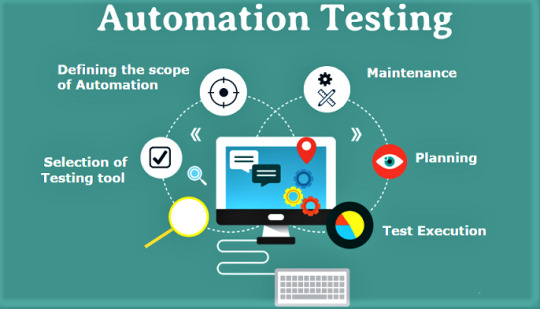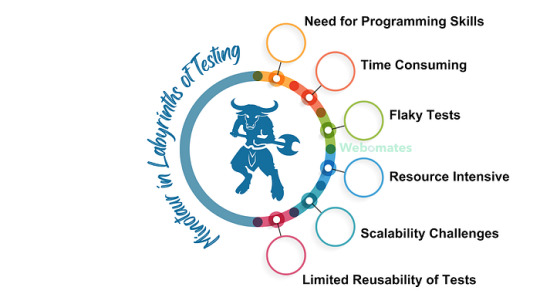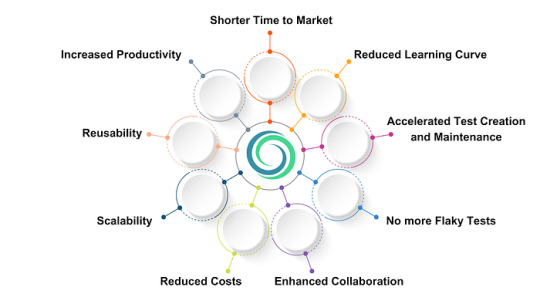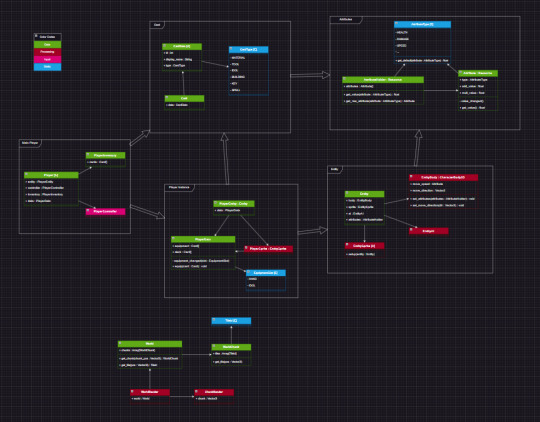#Codeless Automation
Explore tagged Tumblr posts
Text
Future of Automation: Trends and Predictions 2025
As we step into 2025, automation continues to redefine the software testing landscape. The future is not just about faster execution—it's about intelligent, adaptive testing that keeps pace with rapid digital transformation.
One major trend is the rise of AI and machine learning in test automation. AI-driven tools are enabling smart test case generation, self-healing scripts, and predictive defect analysis. This shift reduces manual effort and accelerates time-to-market.
No-code test automation is also gaining momentum, empowering non-technical testers to contribute to automation efforts and shortening the skill gap in QA teams. Meanwhile, hyperautomation—the combination of RPA, AI, and testing—promises end-to-end workflow automation beyond just software testing.
The adoption of cloud-based and containerized test environments is growing, enabling parallel and scalable testing across devices and platforms. Tools like Docker and Kubernetes are becoming essential for modern test orchestration.
Lastly, with DevOps and agile at the core, continuous testing in CI/CD pipelines is becoming the new standard. Organizations that integrate testing earlier and more intelligently will lead in speed and quality.
In 2025, success in QA will come to those who embrace smart automation, flexible frameworks, and a data-driven mindset.
#automation testing#test automation software#qa automation tools#ai testing tools#api testing#qa automation testing#codeless test automation#web automation tools#codeless automation#ai automation testing
0 notes
Text
Automation Testing Insights: Transforming Testing
The global automation testing market size is expected to reach USD 92.45 billion by 2030. Prominent technological advancement in artificial intelligence (AI) and machine learning (ML) is propelling the demand for the market. Mobile application usage is growing across various end-user industries, and smartphone penetration is rising, opening an attractive potential for market expansion. Furthermore, there is a rising demand for automation testing as web-based applications have developed significantly and new software technologies have emerged. The market is growing rapidly due to the increasing usage of ML and AI for advanced analytics and continuous testing across DevOps and DevSecOps areas.

Automation Testing Market Report Highlights
The services segment dominated the market and accounted for over 56% of the global revenue owing to rapid advancements in implementation services, which make it easier to include automation into a functioning infrastructure for software testing
With the aid of this service, automation is integrated into an existing software automation testing setup
The large enterprises segment held the largest revenue share in 2022 as it helps improve efficiency, reduce manual effort, increase test coverage, and ensure the quality of software applications
The BFSI segment is estimated to have significant growth over the forecast period; adopting digitalization in the BFSI sector creates a significant demand for application software automation testing
Gain deeper insights on the market and receive your free copy with TOC now @: Automation Testing Market Report
The emerging use of RPA to automate time-consuming, error-prone manual processes are just a few instances of the usage of AI & ML in automation testing. Moreover, a bot uses the page’s numerous links and web forms to systematically explore through an online application when web crawling or spidering. This is a new use for AI and ML in automation testing. This approach is typically used for indexing online browsing. It may be improved further to perform reverse engineering on an application being tested and automatically find Test Cases. Emerging automation testing tools are significantly fueling market growth.
For instance, Testcraft, a codeless Selenium test automation platform for regression and continuous testing, as well as monitoring of web applications, is gaining traction among users. Their revolutionary AI tech removes maintenance time and cost, as it certainly affects changes in the app. Similarly, Applitools Eyes, Testim, and Test.ai are more automation testing tools propelling the market growth. Furthermore, mergers and acquisitions by other key players are propelling market growth. For instance, in 2022, to improve the user experience on 5G smartphones, Key sight introduced AI-driven and automated testing. Automation and AI enable mobile service providers and app developers to more swiftly evaluate how smartphone users engage with native apps in the real world.
#Automation Testing#Quality Assurance#Software Testing#Test Automation#Continuous Testing#Test Automation Framework#DevOps Testing#Selenium#Test Automation Tools#Performance Testing#Regression Testing#Agile Testing#UIAutomation#Test Scripting#Test Automation Engineer#Codeless Automation#Automation Strategy#CI/CDTesting#Test Automation Best Practices
0 notes
Text
What is Codeless Automation and How its work?

As software development cycles grow faster and more continuous, testing needs to move at the same velocity. Traditional automation—powerful though it is—can become a bottleneck when only a small group of engineers can write and maintain test scripts. Enter codeless test automation, a modern answer to the challenge of scaling quality across teams without requiring everyone to write code.
But codeless is more than just a buzzword—done right, it’s a collaborative, intelligent, and scalable testing methodology that’s redefining how organizations approach QA.
What Is Codeless Test Automation?
Codeless test automation refers to the use of platforms and tools that allow testers to create, execute, and maintain automated tests without writing traditional programming code. Instead of scripting in languages like Java or Python, testers interact with:
Drag-and-drop interfaces
Pre-built test blocks or visual workflows
Natural language inputs or behavior-driven design formats (like Gherkin)
These tools abstract the code behind the scenes, allowing both technical and non-technical team members to contribute to the automation process.
Low-Code vs. No-Code vs. Codeless Automation: Understanding the Differences
Although often used interchangeably, these terms are not the same:
Low-Code Automation provides a blend—it offers visual interfaces but also allows code injections for complex conditions. Perfect for semi-technical testers who want both control and ease.
No-Code Automation eliminates code entirely. It's built for business users and testers with no programming background. Simplicity is the goal—but often at the cost of flexibility.
Codeless Automation, as a broader term, may incorporate both low-code and no-code options. It focuses on abstracting complexity while still offering enough control for power users when needed.
Read also: Best Automation Testing Tools
How Does Codeless Testing Work?
Let’s walk through how a modern codeless automation platform functions:
1. Test Creation
You begin by interacting with the application under test (AUT)—clicking, typing, or performing other actions. The tool records these actions and translates them into a structured test case. Some platforms also allow building tests visually—connecting steps like flowchart blocks or writing plain English test scenarios.
2. Object Recognition
Modern tools use AI-powered selectors or smart locators that adapt when UI elements change. This is crucial because flaky tests are often caused by fragile selectors.
3. Test Data Integration
Need to run the same test for different user types or datasets? Codeless tools can link to spreadsheets, databases, or data generators—without scripting loops or variables.
4. Execution & Scheduling
Tests can be executed locally, on the cloud, or across real devices and browsers. You can schedule them daily or hook them into CI/CD tools like Jenkins, GitHub Actions, or Azure DevOps.
5. Reporting & Analysis
Post-execution, you get visual dashboards, logs, screenshots, and detailed analytics. Some tools even auto-file bugs in Jira when a test fails.
Which Tests Are Best Suited for Codeless Automation?
Not every test type fits codeless automation. It shines in areas like:
• UI Regression Tests
When your product UI evolves frequently, regression test coverage can grow exponentially. Codeless tools make it easier to keep up without burning out your dev team.
• Smoke Tests
Want to validate login, dashboard loading, or payment gateway availability with every build? Codeless tools help you get quick feedback without writing dozens of scripts.
• End-to-End User Journeys
For tests that simulate real-world user paths—like signing up, purchasing a product, and logging out—codeless testing maps these flows efficiently and understandably.
• Cross-Browser / Device Testing
Codeless platforms often integrate with device farms (like BrowserStack or Sauce Labs), letting you run the same test across multiple environments without duplication.
When Not to Use Codeless Automation
Despite its power, codeless isn’t a silver bullet.
Highly complex workflows involving encrypted data, chained APIs, or backend validations still need traditional scripting.
Performance testing, load testing, and deep service-layer tests are beyond the reach of most codeless tools.
If your team needs 100% control over logic, libraries, and exceptions, coded automation is still king.
Final Thoughts
Codeless automation is about making test automation accessible, collaborative, and scalable. It’s not about replacing developers—it's about enabling QA teams to move faster and contribute earlier.
When adopted strategically, codeless testing can reduce time-to-market, increase test coverage, and empower entire teams to contribute to quality.
Want to Get Started With Codeless Automation?
At Testrig Technologies, As a leading Automation Testing Company, we specialize in integrating codeless tools into robust testing ecosystems—balancing ease with enterprise-grade power.
📩 Reach out for a free strategy session, and let’s build a smarter, faster, more inclusive QA process—together.
#automation testing company#codeless automation testing#low code automation testing#qa testing company
0 notes
Text
With the growing complexities of software applications, the need for no-code test automation
has risen significantly. Additionally, the dynamic consumer demands make it crucial for app
developing brands to deliver exceptional user experiences to ensure good customer loyalty and
brand reputation. Of the major automation tools, several enterprises choose Appium as their
primary for their mobile app automation owing to multiple competitive advantages. It's open
source and cost-effective, which helps not only large enterprises but also growing businesses
adopt this tool. However, gaining expertise in using the tool is often time-consuming and
complex. Codeless or no-code automation testing tools without coding has emerged as a
game-changing approach that addresses this challenge.
This article is originally published by
0 notes
Text
The Power of Low Code/No Code Test Automation

If you have been reading my blogs and bytes of wisdom, which I occasionally post on LinkedIn, you would know how much I enjoy using a good analogy. So here we go — in Greek, today.
In the epic quest of software development, the teams navigate treacherous terrain riddled with unknown, and sometimes known, bugs and errors. With Test Automation as their trusted ally, they brave the coding complexities to ensure the quality of their products.
But are they making the right choices?

1. Need for Programming Skills: Open source platforms demand a higher level of programming proficiency.
2. Time-Consuming: Creating and maintaining tests can be time-consuming, especially for complex applications undergoing frequent changes.
3. Flaky Tests: Instabilities in tests due to synchronization issues, dynamic content, or environmental variations.
4. Resource Intensive: Dedicated resources may be needed for script development, leading to higher costs.
5. Scalability Challenges: Scaling test automation with open source tools becomes challenging as application functionalities increase in complexity.
6. Limited Reusability of Tests: Test scripts in open-source tools may lack reusability.
To overcome these challenges, the shift to Low-Code/No-Code (LCNC) platforms proves to be the right choice.
Implementing LCNC technologies can revolutionize work processes, automating tedious tasks and allowing teams to focus on strategic, high-value work. According to McKinsey, “There’s expected to be a 70% growth in the adoption of low-code/no-code by 2025”.
Let’s see what power these platforms hold to help you navigate the challenges faced during software development and testing.
Power of Low-Code/ No-Code Platforms

1. Shorter Time to Market: Code templates and pre-built features reduce development time, resulting in a quicker time to market.
2. Reduced Learning Curve: Minimal coding experience is required, enabling easy use of visual interfaces and pre-built components.
3. Accelerated Test Creation and Maintenance: Drag-and-drop functionality and reusable components speed up the test creation and maintenance process.
4. No more Flaky Tests: LCNC platforms minimize reliance on intricate coding, addressing issues related to dynamic elements and reducing flaky tests.
5. Enhanced Collaboration: Encourages collaboration between business analysts and testers, making development and testing cycles more agile.
6. Reduced Costs: Less dependency on developers for UI tests, allowing testers to contribute to automation and reducing associated costs.
7. Scalability: Handles complex test scenarios and scales according to changing testing process needs.
8. Increased Productivity: Developers can focus on more critical business problems instead of spending hours coding.
9. Reusability: Emphasizes modular designs, allowing for the creation of reusable components and test flows.
The power of LCNC platforms is nothing short of a divine revelation. Businesses are harnessing the power of these platforms to elevate their testing rituals and hasten the delivery of their digital progeny. Yet, in this quest for excellence, it is prudent to acknowledge that specialized guardians are still needed to navigate the labyrinths of software development and perform feats beyond the reach of automated tools.
Much like Athena, the goddess of wisdom, Webomates CQ provides codeless test automation services, seamlessly integrating with various automation frameworks. It bestows the ability to modify test cases effortlessly, ensuring a harmonious coexistence between mortal testers and the divine automation realm.
If you want to discover how codeless testing can help you in achieving excellence, reach out to us at [email protected].
You can read the full blog here
0 notes
Text
Scriptless Test Automation Tools | FireFlink
FireFlink- A scriptless, high-speed automation testing tool with the FireFlink Platform, Cloud, Crowd, & Assets for all of your testing needs. Book a FREE demo!
Visit Website: Scriptless Test Automation Tools
0 notes
Text

Embracing codeless test automation represents the forefront of testing innovation. Whether you are well-versed in codeless testing or just embarking on this journey, explore our offerings.
Our cloud-based codeless platforms empower enterprises to address critical needs related to scalability, speed, collaboration, quality, and security, thereby gaining a competitive edge.
#automation#testautomation#softwaretesting#security#testing#sailotech#lowcodenocode#codeless#processautomation
0 notes
Text

Helo!
I'm back with something else once more but recently I've talked to a college professor of mine and they gave me some good insights on "project management" as in projects in general
So I now have a pretty interesting idea (I hope) for a mix of survival (somewhat, this genre is a bit weird), roguelite, automation and card game!
And the big thing now is I'll be changing how I approach my projects by trying to plan ahead as much as I can and because of that, placing much clearer goals and deadlines
This weekend I've been organizing design stuff and code organization so here ya go:

Not to be confused with unreal blueprints or some codeless coding tool, this is pure diagraming
Now, I haven't actually taken the class on UML stuff (I probably should already have though...) but I have an idea of how it works from work experience and friends so I'm just using that to build my systems maybe not perfectly but I'm discovering how I like to organize stuff as I go
Also I developed a bit of the art as you saw on top of the post because I like conceptualizing the style so I can better imagine how it will turn out in my head
11 notes
·
View notes
Text
Best Practices for Successful Automation Testing Implementation

Automation testing is an essential part of modern-day software development that accelerates delivery, reduces manual work, and improves software quality. But success in automation testing is not assured, it should be achieved by proper planning and execution along with proper compliance of best practices.
In this blog, we will talk about key actionable strategies and best practices to ensure the successful implementation of automation testing in your projects.
1. Start with a Clear Strategy
Jumping straight into automation testing without a clear strategy will not always yield the desired results. Define the following:
Objectives: Define the goals of the automation, whether it is about shorter test cycles, improved test coverage or eliminating human error.
Scope: Set the areas of your application for automation and focus much on areas that have a high impact like regression and functional testing.
Stakeholders: Get early involvement from the development, QA and product teams to avoid misalignment regarding expectations.
A well-formed strategy helps guide the way and make sure everyone involved is aligned.
2. Prioritize the Right Test Cases for Automation
One of automation testing’s biggest mistakes with it is to use automation for everything. Rather than that, shape your test cases to that of:
Are monotonous and time-consuming.
Wherein critical for application functionality
Have stable requirements.
Some of these tests are regression tests, smoke tests, data-driven tests, etc. Do not automate the exploratory or highly dynamic tests that often get changed.
3. Choose the Right Automation Tools
The effectiveness of your automation testing initiative highly relies on appropriate tools selection. Look for tools that:
Support the technology stack of your application (e.g., web, mobile, APIs).
Give the flexibility to expand your project.
Offer extensive reporting, reusability of scripts, and run across browsers.
GhostQA is one example of a codeless platform that works well for teams across the skill set. GhostQA can let you focus on what matters and Auto Healing reduces your maintenance to enforce.
4. Build a Strong Automation Framework
An automation framework is the backbone of your automation testing process. It helps in standardization, reusability and scalability of test scripts. So, when you start designing your framework, make sure to leave some room for these features:
Modularity: Split test scripts into reusable components
Data-Driven Testing: Use Data-Driven Testing to separate test data from the scripts to provide flexibility.
Error Handling: Install anti-malware solutions to prevent potential threats.
A good framework streamlines collaboration and makes it easier to maintain your tests.
5. Write High-Quality Test Scripts
A good test script decides the reliability of your automation testing. To ensure script quality:
When naming scripts, variables, or methods, use meaningful and descriptive names.
For adaptability, you should leverage parameterization instead of hardcoding these values.
Set up appropriate error-handling procedures for handling unforeseen problems.
Do not add anything unnecessarily, the more complexity, the more difficult it is to debug and maintain.
Tools such as GhostQA minimize the efforts put behind scripting providing no-code possibilities allowing even non-technical users to write robust tests.
6. Regularly Maintain Your Automation Suite
Even though automation testing is a great way to ensure quality in applications, one of its biggest challenges is keeping the test scripts updated with application changes. Keeping your test suite effective and up to date, regular maintenance.
Best practices for maintenance include:
Frequent Reviews: Conduct periodic audit of the test scripts to ensure that they are not outdated.
Version Control: Utilize version control systems to maintain history of your script modifications.
Auto-Healing Features: GhostQA and similar tools can track UI updates and modify scripts to reflect changes with little to no human intervention, minimizing maintenance costs.
Take good care of your automation suite so that it doesn't become a liability.
7. Address Flaky Tests
Flaky tests—tests that pass or fail randomly—are a common issue in automation testing. They reduce trust in test results and take up time when debugging. To address flaky tests:
Dig deeper into what might be the underlying causes — timing problems or dynamic elements.
Use explicit waits instead of static waiting in tests to make them aligned with application behavior.
Prefer smart detection-based tools (GhostQA, to be precise) to eliminate the chances of flaky tests.
This translates into flourish as flakiness and is the most significant impact in strengthening confidence in your automation framework.
8. Ensure Cross-Browser and Cross-Platform Compatibility
Most modern applications work across many browsers and devices, so cross-compatibility testing is a necessity. Your automation testing suite must:
Add test cases for popular browsers like Chrome, Firefox, Edge, and Safari.
Testing across different operating systems on mobile (e.g., iOS/Android).
GhostQA abstracts cross-browser and cross-platform testing so you can verify functionality in several types of environments without repeating yourself.
9. Leverage AI and Smart Automation
AI is revolutionizing automation testing with better efficiency and lesser maintenance cost. Next-generation tools like GhostQA powered by AI offer:
Auto-Healing: Automatically adjust to any changes made to the app;such as modified UI elements
Predictive Analysis: Showcase areas with the most potential high risk to prioritize tests.
Optimized Execution: Run just the tests that yield the most performance insights.
Use AI-Powered Tools as these can help you to increase the efficiency and accuracy of your testing.
10. Monitor and Measure Performance
To measure the effectiveness of your automation testing, you should track key metrics that include:
Test Coverage: Number of automated tests covering application features.
Execution Time: Time taken to execute automated test suites.
Defect Detection Rate: Number of bugs detected in automation testing
Flaky Test Rate: Frequency of inconsistent test results.
Consistent assessment of these metrics helps in discovering the areas of improvement in your automation efforts while also exhibiting the ROI of the same.
Conclusion
So, the right approach of selecting the right tool and plan properly will help to do a successful automation testing implementation. This could be achieved by adopting best practices like prioritizing test cases, maintaining test scripts, making use of the AI-powered tools and collaborating with other stakeholders in the process.
Tools like GhostQA, which come equipped with codeless testing, auto-healing features, and user-friendly interfaces, empower teams of both technical and non-technical backgrounds to streamline their automation processes and devote their attention to shipping quality software.
#automation testing#software testing#test automation#functional testing#automation tools#quality assurance
2 notes
·
View notes
Text
Pioneering the Future of Software Quality Assurance through Automation Testing
Automation testing, a dynamic and essential software quality assurance technique, is reshaping the landscape of application testing. Its mission is to execute predefined test cases on applications, delivering heightened accuracy, reliability, and efficiency by automating tedious and time-consuming testing tasks.

The Present and Future Synergy in Automation Testing:
At its essence, automation testing responds to the pressing need for a streamlined testing process. Beyond its current significance, the future promises a paradigm shift, characterized by transformative trends and advancements.
Unveiling Future Trends in Automation Testing:
Proactive "Shift-Left" Testing: Embracing a proactive "Shift-Left" approach, the future of automation testing integrates testing earlier in the development life cycle. This strategic shift aims to detect and address issues at their inception, fostering a more resilient and efficient software development process.
Harmonizing with DevOps: Automation is positioned to become increasingly integral to DevOps practices. Its seamless integration into continuous integration and delivery (CI/CD) pipelines ensures not just faster but more reliable releases, aligning seamlessly with the agile principles of DevOps.
AI and Machine Learning Synergy: The convergence of artificial intelligence (AI) and machine learning (ML) is poised to revolutionize automation testing. This integration enhances script maintenance, facilitates intelligent test case generation, and empowers predictive analysis based on historical data, ushering in a new era of adaptive and efficient testing processes.

Evolving Cross-Browser and Cross-Platform Testing: In response to the diversification of the software landscape, automation tools are evolving to provide robust solutions for cross-browser and cross-platform testing. Ensuring compatibility across diverse environments becomes paramount for delivering a seamless user experience.
Codeless Automation Revolution: The ascent of codeless automation tools represents a pivotal shift in testing methodologies. This trend simplifies testing processes, enabling testers with limited programming skills to create and execute automated tests. This democratization of testing accelerates adoption across teams, fostering a collaborative testing environment.
Concluding the Journey: Navigating Future Imperatives:
In conclusion, automation testing transcends its current role as a necessity, emerging as a future imperative in the ever-evolving landscape of software development. As technologies advance and methodologies mature, automation testing is poised to play a pivotal role in ensuring the delivery of high-quality software at an accelerated pace. Embracing these future trends, the software industry is set to embark on a transformative journey towards more efficient, adaptive, and reliable testing processes.
3 notes
·
View notes
Text
Common Pitfalls in App Test Automation and How to Avoid Them
App test automation can unlock faster releases and better quality—but only if done right. Many teams jump in with good intentions, only to hit common pitfalls that slow progress or waste resources. This blog highlights frequent mistakes and how to sidestep them.
Automating Everything:
Not all tests need automation. Trying to automate UI-heavy or rarely-used scenarios can increase maintenance. Focus on high-value, repeatable tests like regressions and smoke tests.
Poor Tool Selection:
Choosing a tool that doesn’t align with your app’s platform, tech stack, or team skills leads to frustration. Evaluate tools based on compatibility, learning curve, and integration capabilities.
Lack of Test Design Strategy:
Writing flaky, unstructured tests results in unreliable outcomes. Implement a solid test design pattern (e.g., Page Object Model) and follow naming conventions.
Ignoring Maintenance:
Automated tests need regular updates. If ignored, they become outdated and produce false positives or failures.
Skipping CI/CD Integration:
Running tests manually defeats the purpose. Integrate automation into your CI/CD pipeline to ensure continuous, consistent testing.
By avoiding these pitfalls, teams can create a sustainable and scalable automation strategy that supports rapid, high-quality app development.
#app test automation#end to end testing#api automation testing tools#automated web testing#qa automation testing#ai automation testing#codeless automation
0 notes
Text
Codeless Test Automation: Revolutionize Software Testing in 2025

Software testing enters a new era with codeless test automation. Organizations aim to deliver quality products faster and more efficiently. ideyaLabs empowers businesses to embrace this future with advanced codeless test automation strategies. Discover the essentials, benefits, and applications of this innovative approach.
Explore the New Era of Codeless Test Automation
Codeless test automation disrupts traditional testing practices. Manual scripting becomes obsolete. Modern platforms allow users to create automated tests without writing a single line of code. Teams with diverse backgrounds contribute to the testing process. Codeless tools revolutionize how organizations approach quality assurance.
What Is Codeless Test Automation?
Codeless test automation enables users to create, execute, and manage automated tests using visual interfaces or simple drag-and-drop features. Coding expertise remains unnecessary. Professionals with limited programming experience design, run, and maintain automated test scripts. This approach accelerates software development lifecycles.
Why Codeless Test Automation Gains Popularity
Business demands for rapid deployment and frequent updates increase. Codeless test automation tools meet these requirements by automating repetitive tasks efficiently. Enterprises save time and cut costs. ideyaLabs supports seamless integration of codeless solutions for diverse industries.
Key Benefits of Codeless Test Automation
Increased Efficiency Codeless tools accelerate test creation. They reduce development and maintenance cycles. Testing teams achieve higher throughput and efficiency.
Lower Learning Curve Testers from non-technical backgrounds use intuitive interfaces. Extensive training becomes unnecessary. Businesses onboard new testers quickly.
Cost Savings Automated testing reduces manual efforts. Organizations optimize resource usage. ideyaLabs helps maximize return on investment.
Fast Adaptation Change implementation takes place in minutes, not days. Teams adapt to evolving business needs comfortably. Product quality remains high.
Enhanced Collaboration Business analysts, QA engineers, and stakeholders work together. Cross-functional collaboration improves product outcomes.
Common Use Cases for Codeless Test Automation
Web Application Testing Organizations automate browser interactions, UI validation, and end-user workflows.
Mobile Application Testing Teams automate tests for Android and iOS devices. App stability and cross-device compatibility increases.
Functional Testing Codeless tools verify feature functionality across platforms. Testers ensure seamless business process execution.
Regression Testing Teams automate the re-testing of existing features. This confirms new changes do not break existing functionality.
API Testing Codeless solutions facilitate end-to-end validation of APIs and data exchange mechanisms.
Core Features of Modern Codeless Test Automation Tools
Visual Workflow Editors: Drag-and-drop interfaces define test steps.
Reusable Components: Pre-built modules increase productivity.
Data-driven Testing: Parameterization allows for wider test coverage.
Integration Support: Connect with CI/CD pipelines and test management tools.
Cross-browser and Device Testing: Run tests across diverse environments easily.
Test Reporting and Analytics: Detailed insights identify issues and track progress.
ideyaLabs focuses on leveraging best-in-class features for clients.
How ideyaLabs Implements Codeless Test Automation
ideyaLabs tailors codeless automation to your needs. Consultants assess your workflows. Teams integrate customized codeless solutions seamlessly into existing pipelines. ideyaLabs ensures compatibility with your development tools, frameworks, and processes. Businesses experience smooth transitions and rapid results.
Overcoming Challenges in Codeless Test Automation
Every innovation brings unique challenges. ideyaLabs offers proactive solutions.
Scope Limitations Not every test scenario fits codeless frameworks. ideyaLabs identifies test cases best suited for automation. Customized strategies ensure maximum coverage and accuracy.
Maintenance Overhead Codeless tools require regular updates. ideyaLabs provides ongoing support for test script optimization.
Integration Issues Diverse tools and frameworks sometimes cause integration challenges. ideyaLabs offers expert guidance and technical assistance for seamless integration.
Scalability Concerns Enterprise applications demand scalability. ideyaLabs delivers solutions designed for growth.
Best Practices for Successful Codeless Test Automation
Clearly define testing objectives and criteria.
Select tools that align with business goals.
Collaborate across departments for requirement gathering.
Design modular and reusable test components.
Regularly review and update test cases.
Integrate automation with CI/CD pipelines.
Leverage analytics for continuous improvement.
ideyaLabs helps businesses implement industry best practices for continual success.
Future Trends in Codeless Test Automation for 2025
Codeless test automation evolves rapidly. Artificial intelligence and machine learning improve test creation and maintenance. Self-healing test scripts automatically adjust to application changes. Integration with DevOps and cloud-based workflows becomes standard. ideyaLabs stays at the forefront of these advancements to deliver maximum value.
Why ideyaLabs Leads in Codeless Test Automation
ideyaLabs pioneers’ codeless automation with client-centric strategies. Clients benefit from customized implementations and ongoing support. ideyaLabs possesses extensive domain expertise and commitment to innovation. Your organization achieves faster releases, higher quality, and reduced costs. Partner with ideyaLabs to unlock the full power of codeless test automation.
Start Your Codeless Test Automation Journey with ideyaLabs
Embrace the future of quality assurance. Codeless test automation gives your business a competitive edge. ideyaLabs guides organizations at each step. Adopt cutting-edge tools and techniques. Propel your software development teams to new heights. Contact ideyaLabs and lead the change in 2025.
0 notes
Text
Automated Testing Software Market Global Industry Analysis | Trends 2025-2033

The Reports and Insights, a leading market research company, has recently releases report titled “Automated Testing Software Market: Global Industry Trends, Share, Size, Growth, Opportunity and Forecast 2025-2033.” The study provides a detailed analysis of the industry, including the global Automated Testing Software Market share, size, trends, and growth forecasts. The report also includes competitor and regional analysis and highlights the latest advancements in the market.
Report Highlights:
How big is the Automated Testing Software Market?
The global automated testing software market was valued at US$ 6.6 billion in 2024 and is expected to register a CAGR of 7.4% over the forecast period and reach US$ 12.6 billion in 2033.
What are Automated Testing Software?
Automated testing software comprises tools and frameworks created to automate the running of tests for software applications. It enables developers and quality assurance teams to efficiently test software functionality, performance, and security by executing pre-scripted tests. This software can mimic user interactions, detect bugs and errors, and provide comprehensive reports on test outcomes. Its use enhances testing speed and accuracy, resulting in quicker development cycles and improved software quality.
Request for a sample copy with detail analysis: https://www.reportsandinsights.com/sample-request/1735
What are the growth prospects and trends in the Automated Testing Software industry?
The automated testing software market growth is driven by various factors and trends. The market for automated testing software is experiencing rapid expansion within the software industry, propelled by the widespread adoption of agile and DevOps methodologies. This market encompasses a range of tools and platforms aimed at automating testing processes, enhancing software quality, and expediting time-to-market. Key drivers of market growth include the increasing requirement for continuous testing, the imperative to cut down testing expenses and time, and the escalating complexity of software applications. Additionally, the market is influenced by the escalating trend of digital transformation across industries, which necessitates dependable testing solutions to ensure software applications' reliability and performance. Hence, all these factors contribute to automated testing software market growth.
What is included in market segmentation?
The report has segmented the market into the following categories:
By Type of Testing:
Functional Testing
Performance Testing
Security Testing
Compatibility Testing
Usability Testing
Others
By Testing Tool:
Test Management Tools
Functional Testing Tools
Performance Testing Tools
Security Testing Tools
Codeless Testing Tools
Others
By Deployment Mode:
On-Premises
Cloud-based
By Organization Size:
Small and Medium-sized Enterprises (SMEs
Large Enterprises
By End-User Industry:
IT and Telecom
BFSI (Banking, Financial Services, and Insurance)
Healthcare
Retail
Manufacturing
Government and Public Sector
Media and Entertainment
Others
Segmentation By Region:
North America:
United States
Canada
Europe:
Germany
The U.K.
France
Spain
Italy
Russia
Poland
BENELUX
NORDIC
Rest of Europe
Asia Pacific:
China
Japan
India
South Korea
ASEAN
Australia & New Zealand
Rest of Asia Pacific
Latin America:
Brazil
Mexico
Argentina
Middle East & Africa:
Saudi Arabia
South Africa
United Arab Emirates
Israel
Who are the key players operating in the industry?
The report covers the major market players including:
IBM Corporation
SmartBear Software
Tricentis
Ranorex GmbH
TestComplete
Selenium
Appium
Sauce Labs Inc.
Parasoft Corporation
Eggplant (formerly TestPlant)
Cigniti Technologies
QualiTest Group
Broadcom Inc. (formerly CA Technologies)
Hewlett Packard Enterprise (HPE)
View Full Report: https://www.reportsandinsights.com/report/Automated Testing Software-market
If you require any specific information that is not covered currently within the scope of the report, we will provide the same as a part of the customization.
About Us:
Reports and Insights consistently mееt international benchmarks in the market research industry and maintain a kееn focus on providing only the highest quality of reports and analysis outlooks across markets, industries, domains, sectors, and verticals. We have bееn catering to varying market nееds and do not compromise on quality and research efforts in our objective to deliver only the very best to our clients globally.
Our offerings include comprehensive market intelligence in the form of research reports, production cost reports, feasibility studies, and consulting services. Our team, which includes experienced researchers and analysts from various industries, is dedicated to providing high-quality data and insights to our clientele, ranging from small and medium businesses to Fortune 1000 corporations.
Contact Us:
Reports and Insights Business Research Pvt. Ltd. 1820 Avenue M, Brooklyn, NY, 11230, United States Contact No: +1-(347)-748-1518 Email: [email protected] Website: https://www.reportsandinsights.com/ Follow us on LinkedIn: https://www.linkedin.com/company/report-and-insights/ Follow us on twitter: https://twitter.com/ReportsandInsi1
#Automated Testing Software Market share#Automated Testing Software Market size#Automated Testing Software Market trends
0 notes
Text
Codeless Automation Testing- All you need to know
With the growing complexities of software applications, the need for no-code test automation has risen significantly. Additionally, the dynamic consumer demands make it crucial for app-developing brands to deliver exceptional user experiences to ensure good customer loyalty and brand reputation. Of the major automation tools, several enterprises choose Appium as their primary for their mobile app automation owing to multiple competitive advantages. It's open-source and cost-effective, which helps not only large enterprises but also growing businesses adopt this tool. However, gaining expertise in using the tool is often time-consuming and complex. Codeless or no-code automation testing tools without coding has emerged as a game-changing approach that addresses this challenge.
No-code test automation offers unprecedented efficiency, accessibility, and collaboration. By eliminating the need for extensive programming knowledge, it empowers testers of all technical backgrounds to actively participate in the automation journey.
Today, no-code test automation tools have gained significant popularity in the industry. The demand for these tools has increased as organizations strive to accelerate their testing processes and involve non-technical team members in no-code automated testing.
This article is originally published by https://www.headspin.io/blog/codeless-appium-test-automation-with-headspin
0 notes
Text
Automation Testing Market Size, Share, Analysis, Forecast, and Growth Trends to 2032: Software Quality Becomes a Strategic Priority
The Automation Testing Market was valued at USD 29.4 billion in 2023 and is expected to reach USD 118.6 billion by 2032, growing at a CAGR of 16.80% over 2024-2032.
The Automation Testing Market is experiencing a transformative shift as businesses increasingly prioritize faster time-to-market and enhanced software quality. Driven by the rising demand for digital transformation and agile methodologies, automation testing has become a critical element in software development lifecycles. Organizations are embracing automated solutions to minimize manual intervention, reduce errors, and ensure consistent performance across platforms.
Automation Testing Market continues to gain traction across sectors such as BFSI, healthcare, retail, telecom, and manufacturing. With the growing complexity of applications and integration of AI and machine learning into testing tools, the market is evolving rapidly. Enterprises are not just automating repetitive test cases but also leveraging intelligent automation to predict defects, improve test coverage, and enhance user experiences.
Get Sample Copy of This Report: https://www.snsinsider.com/sample-request/4127
Market Keyplayers:
Selenium - Selenium WebDriver
Tricentis - Tosca
IBM - Rational Functional Tester
Micro Focus - UFT (Unified Functional Testing)
SmartBear - TestComplete
Cucumber - CucumberStudio
Appium - Appium
Katalon - Katalon Studio
Ranorex - Ranorex Studio
Worksoft - Worksoft Certify
Sahi - Sahi Pro
LambdaTest - LambdaTest
Eggplant - Eggplant Functional
Perfecto - Perfecto Test Automation
TestComplete - TestComplete
Telerik - Test Studio
Sauce Labs - Sauce Labs Selenium Grid
Applitools - Visual AI Testing
Postman - Postman API Testing
Tricentis – qTest
Market Analysis
The automation testing landscape is driven by rapid technological advancements and the increasing need for efficient, error-free deployment processes. Businesses are adopting DevOps and continuous integration/continuous deployment (CI/CD) pipelines, fueling the demand for scalable and flexible testing solutions. Cloud-based testing platforms and open-source tools have further expanded accessibility, enabling SMEs to compete alongside large enterprises. The growth of mobile and web applications has also intensified the requirement for robust cross-platform testing frameworks.
Market Trends
Rise of AI and Machine Learning: Intelligent automation is empowering predictive analytics in testing, enhancing accuracy and speed.
CI/CD Integration: Seamless integration of automation tools into CI/CD pipelines accelerates development cycles.
Cloud-Based Testing: Scalable cloud infrastructure enables remote and parallel testing environments.
Codeless Automation Tools: These tools are lowering the technical barriers, making automation accessible to non-developers.
Increased Adoption in SMEs: Open-source frameworks and SaaS models are driving adoption across small and medium businesses.
Market Scope
Expanding Across Verticals: Automation testing is being adopted in healthcare, eCommerce, BFSI, telecom, and automotive industries.
Global Penetration: North America leads, but Asia-Pacific is emerging rapidly with digitization initiatives.
Beyond Functional Testing: Growth in performance, security, and usability testing automation.
Support for Emerging Tech: Evolving tools support IoT, blockchain, and AR/VR applications.
High ROI Potential: Reduced human error, faster testing cycles, and better product quality.
As the demand for seamless user experiences and reliable digital platforms grows, the market's potential continues to expand. From startups to multinational corporations, the focus on automation is no longer optional but essential.
Market Forecast
The future of the Automation Testing Market is poised for exponential growth, powered by innovation and demand for faster, higher-quality releases. As enterprises transition from legacy testing methods to modern, AI-driven frameworks, automation is expected to redefine how software is built, tested, and delivered. With continuous investments in R&D and vendor competition heating up, the market is set to witness breakthroughs in intelligent test orchestration, self-healing scripts, and hyper-automation capabilities.
Access Complete Report: https://www.snsinsider.com/reports/automation-testing-market-4127
Conclusion
In a world where digital agility defines success, the Automation Testing Market stands as a pivotal force in accelerating innovation. For businesses aiming to stay competitive, embracing automation isn't just a trend—it's a strategic imperative. Whether you're a tech leader, a QA professional, or an enterprise innovator, now is the time to capitalize on the wave of transformation driving this dynamic market forward.
About Us:
SNS Insider is one of the leading market research and consulting agencies that dominates the market research industry globally. Our company's aim is to give clients the knowledge they require in order to function in changing circumstances. In order to give you current, accurate market data, consumer insights, and opinions so that you can make decisions with confidence, we employ a variety of techniques, including surveys, video talks, and focus groups around the world.
Contact Us:
Jagney Dave - Vice President of Client Engagement
Phone: +1-315 636 4242 (US) | +44- 20 3290 5010 (UK)
#Automation Testing Market#Automation Testing Market Scope#Automation Testing Market Share#Automation Testing Market Size#Automation Testing Market Trends
0 notes
Text
Automation Testing Tools | FireFlink
FireFlink- A scriptless, high-speed automation testing tool with the FireFlink Platform, Cloud, Crowd, & Assets for all of your testing needs. Book a FREE demo!
Visit Website: Automation Testing Tools
0 notes